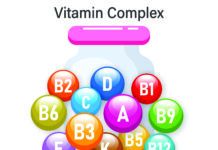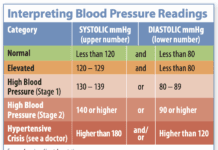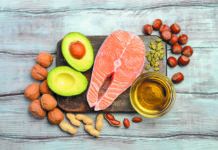Image © alxpin | Getty Images
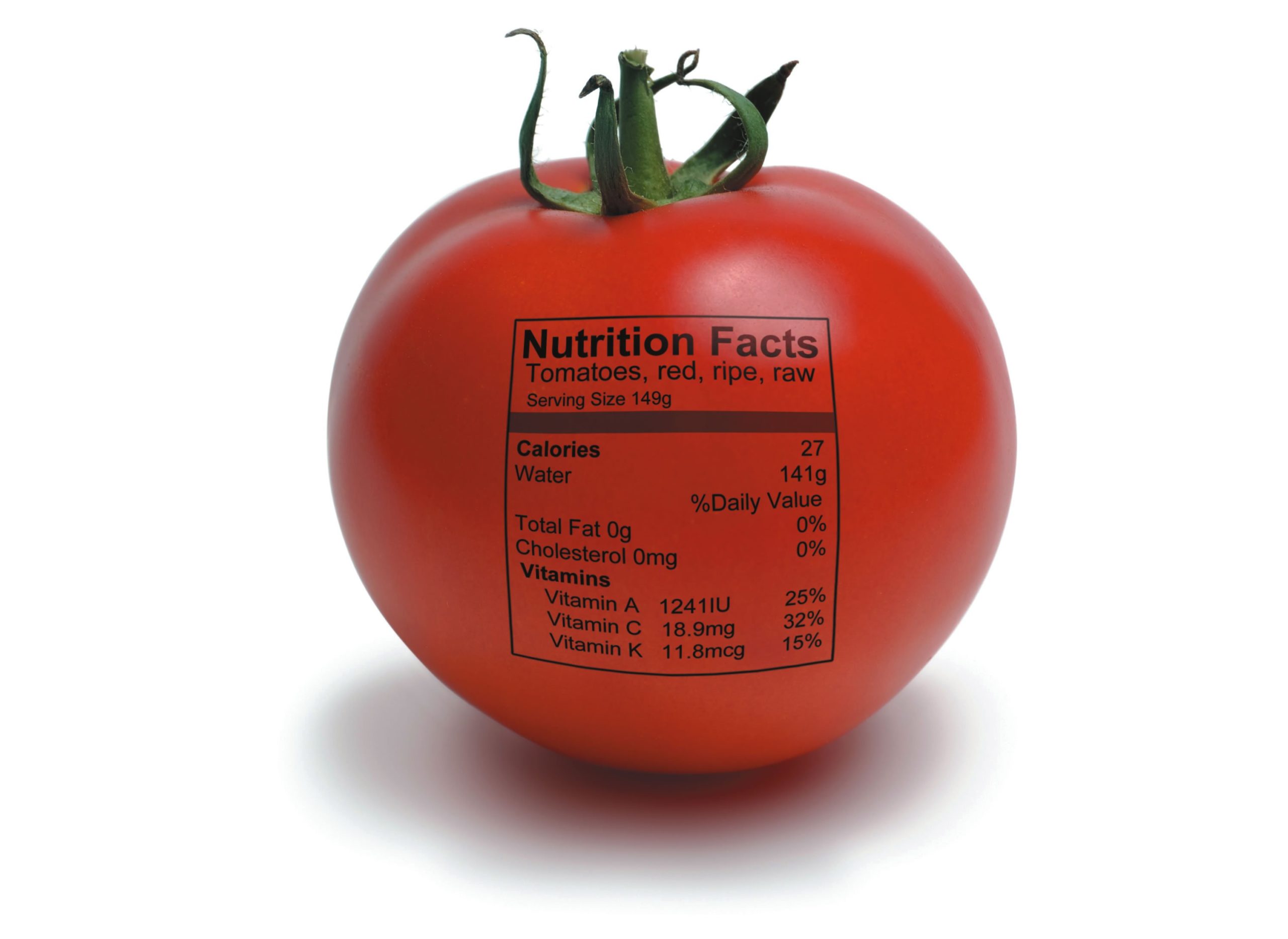
The U.S. Food and Drug Administration (FDA) has finalized regulations mandating several important changes on the Nutrition Facts panels on packaged foods. “Poor diets are the leading cause of poor health and rising healthcare costs in America,” says Jerold Mande, MPH, a professor at Tufts’ Friedman School of Health Science and Policy who, as senior advisor to the commissioner of the Food and Drug Administration, led the design of the original Nutrition Facts label. “The new label can help us as we work to solve this underappreciated nutrition crisis.” Here is a rundown of the changes.
1. Servings. All of the nutrient information shown on a Nutrition Facts label applies to the listed serving size. If a label says a package contains three servings, for example, someone who consumes the entire package would be getting triple the calories and nutrients listed. In order to make it more obvious what quantity of the food the calories and nutrient information actually relate to, “serving size” and “servings per container” are now more prominently displayed.
The new label regulations also require listed serving sizes to more closely reflect what Americans actually eat and drink today, based on national data on dietary habits. For example, the serving size that is required to be listed for ice cream has increased from half a cup to two thirds of a cup. Also, any package that contains between one and two servings must now be labeled as a single serving package. For example, although, for labelling purposes, the FDA considers a serving of soda to be 12 ounces, a 20-ounce bottle must also be labeled as one serving, because people tend to drink all 20 ounces in one sitting.
The serving size on labels should not be confused with recommended servings of a food or drink. “It is essential that consumers understand the ‘serving size’ on packaged food and beverages is based on what people typically eat, not on what they should be eating,” says Alice H. Lichtenstein, DSc, senior scientist at Tufts’ Jean Mayer USDA Human Nutrition Research Center on Aging and executive editor of Tufts Health & Nutrition Letter. “Don’t count on the serving sizes on labels to ensure the food fits into daily calorie needs or a healthy dietary pattern.”
2. Calories. Number of calories is now the most prominent feature on the label. “I believe this is an important change, because being aware of calories helps focus our attention on overweight and obesity, which are a leading problem in today’s nutrition crisis,” says Mande. But individuals should not compare or choose foods solely on the basis of their calorie counts. Some low-calorie foods have little nutritional value and/or may be high in sodium, added sugars, or refined starches, while some higher calorie choices may be rich in health-promoting components like healthy fats, fiber, or calcium. For example, says Lichtenstein, “chicken broth may be low in calories, but it’s extremely high in sodium and little else. Salmon, although relatively high in calories, contains beneficial omega-3 fatty acids and protein.”
Of note, the listing of “Calories from fat” has been removed from Nutrition Facts labels, as current science supports the view that the type of fat consumed is more important than the total amount of fat. “That’s a positive change,” says Dariush Mozaffarian, MD, DrPH, dean of Tufts’ Friedman School of Nutrition Science and Policy and editor-in-chief of Tufts Health & Nutrition Letter. “Foods rich in nuts, avocados, plant oils, and other healthy fats should be encouraged, not avoided.”
3. Sodium. The Daily Value for sodium has been reduced. The percent Daily Value (%DV) is now based on an upper limit of 2,300 milligrams (mg) of sodium per day, down from 2,400 mg. The current average intake of sodium in the United States is about 3,400 mg per day.
4. Dietary Fiber. The daily value for dietary fiber has gone up from a goal of 25 grams per day to 28 grams per day. Manufacturers may choose to include amounts of soluble and insoluble fibers.
5. Added Sugars.Added Sugars will now appear as a subcategory of Total Sugars. “This is a very important change,” says Mande, “because added sugars are a good marker of the nutrition quality of a food.” Added sugars (those not found naturally in whole foods like fruit and dairy) are found in a wide variety of foods, and include sugars from cane sugar, beet sugar, syrups, honey, concentrated fruit or vegetable juices, and high fructose corn syrup. The 2015 Dietary Guidelines for Americans support limiting calories from added sugars to less than 10 percent of total daily calories. For a 2,000 calorie per day diet, that means no more than 200 calories each day should come from added sugars, which is about 50 grams (g) of sugar. To put that in context, a single serving (2.2 ounce) bag of a typical fruit-flavored candy has about 46 g of added sugars; and a single 20 ounce serving of soda, about 60 g.
6. Vitamins and Minerals. The list of vitamins and minerals that are required or permitted on the label has been updated. Since inadequate intakes of vitamins A and C are rare in America today, data on content of these two vitamins is no longer required (although manufacturers can still choose to list them). Information on vitamin D and potassium have been added to the label because Americans often do not get the recommended dietary amount of these two nutrients. Manufacturers must now declare the actual amount, in addition to the %DV, of vitamin D, calcium, iron, and potassium. They can voluntarily declare the amount for other vitamins and minerals.
7. Other Changes. The old footnote that listed daily values for different calorie levels has been replaced with a definition of percent Daily Value. In addition to these changes to the standard Nutrition Facts labels, the new FDA regulations also cover changes to labels on foods designed specifically for use by infants and children under age four, and for nutritional supplement labels.
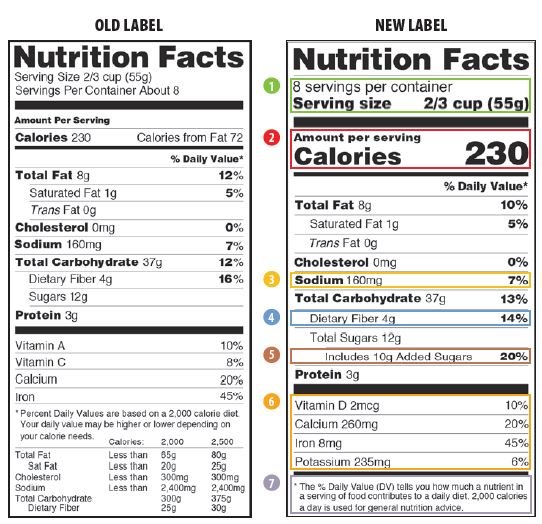
Requirements for grams of total fat, protein, cholesterol, and total carbohydrate has not changed, although nutrition recommendations and thinking about these constituents has shifted. For example, the U.S. Dietary Guidelines Advisory Committee recommended removing the upper limit on total fat. “You can ignore this line on the label,” says Mozaffarian. “One can’t tell much about health from just knowing total fat.” Information on protein is also unnecessary for healthy individuals—most Americans get plenty of protein in their diet. Additionally, the Dietary Guidelines concluded that dietary cholesterol is no longer a “nutrient of concern” for overconsumption in the U.S.
When considering the Total Carbohydrate line, be aware that the label does not differentiate between different kinds of carbohydrates. Refined carbohydrates (starch) are associated with similar negative health effects as sugars, whereas whole grains are not. To cut down on refined carbohydrates, check ingredient lists for whole grains and whole-grain flours. Another approach is to check the ratio of total carbohydrate to total fiber per serving: research suggests aiming for at least one gram of fiber for every 10 grams of total carbohydrate.
“Labels help consumers make more informed food choices,” says Mande, “but they also nudge food companies to reformulate their products. For example, adding trans fat to the label led companies to remove it from foods.” It’s important to keep in mind that Nutrition Facts labels are only found on packaged foods; foods like fruits and vegetables are not required to have labels. These whole foods are naturally low in sodium, have no added sugars, and are typically rich in essential nutrients. So, while Nutrition Facts labels can help consumers make informed choices, some of the best choices are foods with no label at all.
Try these tips to get the most out of the new Nutrition Facts labels:
-Look at number of servings per container and serving size first. Use that information to determine how much of the product fits into a healthy overall diet.
-Aim to stay under 100% DV of things like sodium and added sugars over the day. Try to consume as close to 0 grams of trans fat as possible.
-Aim to reach 100% DV of dietary fiber, vitamin D, calcium, iron, and potassium.
-For grain-rich products, aim for products with at least one gram of fiber for every 10 grams of carbohydrate.
-Use Nutrition Facts labels to compare products within the same category. For example, compare labels on crackers to choose those with more fiber and less sodium.
The Percent Daily Values (% DV) provided on the right-hand side of the Nutrition Facts panel are designed to help consumers see how a product fits into their overall dietary pattern. Aim to reach 100% of things like fiber, vitamins, and minerals, and to stay below 100% of things like trans fat, sodium, and added sugars. Percent DV can also be used to compare products within categories of foods (but check to make sure the serving sizes are the same).







